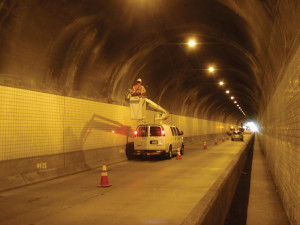Following the tragic ceiling collapse in the Interstate 90 Connector Tunnel in Boston, Massachusetts, on July 10, 2006, the National Transportation Safety Board’s Highway Accident Report, NTSB Number HAR-07/02, identified several safety issues including, “inadequate regulatory requirements for tunnel inspections.” On July 6, 2012, President Obama signed the Moving Ahead for Progress in the 21st Century Act (MAP-21), which required the Secretary to establish national standards for tunnel inspections. Thus, the impetus for a tunnel safety inspection program can be traced back nearly ten years, with the requirement to develop national tunnel inspection standards mandated nearly four years ago.
Recognizing that the safety and security of the Nation’s tunnels are of paramount importance, Congress declared in MAP-21: it is in the vital interest of the country, to inventory, inspect and improve the condition of the Nation’s highway tunnels. The Federal Highway Administration (FHWA) has developed, over the last six years, tunnel inspection regulations (standards) and two supporting reference documents (a manual and specifications):
- National Tunnel Inspection Standards (NTIS),
- Tunnel Operation, Maintenance, Inspection and Evaluation (TOMIE) Manual, and
- Specifications for the National Tunnel Inventory (SNTI).
The National Tunnel Inspection Standards (NTIS) establishes the regulations for the uniformity of tunnel inspections similar to the National Bridge Inspection Standards (NBIS) for bridges. The TOMIE Manual establishes procedures and practices for tunnel inspection and documentation of deficiencies similar to the Bridge Inspector’s Reference Manual (BIRM) for bridges. The SNTI enables the inspector to inventory and assess tunnel elements and functional systems similar to the AASHTO Manual for Bridge Element Inspection and the FHWA Recording and Coding Guide for bridges. Qualifications and responsibilities for tunnel program managers, tunnel inspection team leaders, tunnel load raters and tunnel inspectors, along with safety precautions and quality assurance and quality control, are detailed in these documents. Specific requirements for becoming a National Certified Tunnel Inspector (NCTI) were also delineated.

HDR inspector using a bucket van to access the arched concrete roof of a tunnel during a routine inspection.
National Tunnel Inspection Standards (NTIS)
Tunnels were not addressed in the National Bridge Inspection Standards (NBIS), bridge inspection manuals or training. In 2008, the FHWA initiated steps to implement the National Tunnel Inspection Standards (NTIS). The process began with the publication of the Advanced Notice of Proposed Rule-Making (ANPRM). After addressing the comments received on the ANPRM, a Notice of Proposed Rule-Making was developed and published in 2010; however, before completing the rule-making process in 2012, MAP-21 was signed into law. This highway law contained a number of tunnel inventory and inspection provisions which needed to be addressed. In July of 2013, the FHWA issued a Supplementary Notice of Proposed Rule-Making (SNPRM) to incorporate the new provisions and to seek comments. The final rule addressed the comments on the SNPRM. When published in the Office of the Federal Register on July 14, 2015, the NTIS became part of the Code of Federal Regulations – 23 CFR Part 650 Subpart E.
The effective date for the NTIS was 30 days after publication; therefore, on August 13, 2015, the requirements began for all tunnels on public roads, on and off Federal-aid highways. The intent of the new highway regulation is to establish a basis for uniform and consistent inventory and inspection procedures for all tunnels located on public roads. Under the NTIS, critical findings are to be reported to the FHWA and corrected promptly. The mandate calls for a national tunnel inventory and inspection program, tunnel routine inspection frequency of 24 months, training for tunnel inspectors, and a national certification program for tunnel inspectors.
Together with the National Highway Institute (NHI), the FHWA developed a comprehensive training course that provides national certification for tunnel inspectors. Key inspection personnel, including the program manager and team leaders, are required to become Nationally Certified Tunnel Inspectors (NCTI). As a substitute for this certification, the NTIS also permits training which has been developed by the State and approved by the FHWA.
To that end, the FHWA contracted with Michael Baker International to develop FHWA-NHI Course 130110 Tunnel Safety Inspection to provide instructor-led comprehensive training for tunnel inspectors in accordance with the NTIS. The course development team included HDR Engineering, Inc., with Subject Matter Experts (SMEs) for civil/structural, mechanical and electrical disciplines; and Engility with expertise in gaming simulation to develop the Virtual Tunnel Inspection (VTI) Computer Based Training (CBT) capstone exercise. The tunnel safety inspection course is comprised of modules covering Course Introduction, Overview of Tunnel Inspection, Tunnel Inspection Fundamentals, Inspection of Structural Tunnel Elements, Inspection of Civil Tunnel Elements, Inspection of Mechanical System Tunnel Elements, Inspection of Fire/Life Safety/Security System Tunnel Elements, Inspection of Electrical System Tunnel Elements, Inspection of Signage and Lighting System Tunnel Elements, and End of Course Review (including the VTI Exercise). The Baker+HDR Team was subsequently selected to deliver the new FHWA-NHI Course 130110 Tunnel Safety Inspection. Beginning with the first course offering in August 2015 (two weeks following the effective date of the NTIS), the Baker+HDR Team taught a total of 15 classes throughout the U.S. through May 2016. With each class averaging 30 attendees, to date, approximately 450 NCTIs have been issued.
For reference, the NTIS defines a tunnel as: “an enclosed roadway for motor vehicle traffic with vehicle access limited to portals, regardless of type of structure or method of construction, that requires, based on the owner’s determination, special design considerations to include lighting, ventilation, fire protection systems, and emergency egress capacity. The term ‘tunnel’ does not include bridges or culverts inspected under the National Bridge Inspection Standards (23 CFR 650 Subpart C – National Bridge Inspection Standards).” This definition is consistent with the definition used by the American Association of State Highway and Transportation Officials (AASHTO), and it is intended to identify the structures targeted by this new regulation.▪
